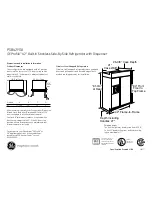
819091D
63
How to use the In-line Pressure Gauge:
Step 1:
Cut and connect the pipe circuit to be tested to the in-line pressure gauge and braze this joint.
Step 2:
At the other end of the pipe circuit being tested, crimp off the pipe with crimp off pliers and braze this end off to
totally seal the circuit.
Step 3:
Connect a nitrogen bottle to the in-line pressure gauge by means of a hose with a Schrader valve depressing
key in the hose coupling.
Step 4:
Open the nitrogen bottle fully with the regulator backed off.
Step 5:
Increase the regulator pressure in the circuit being tested to 150 psi.
Step 6:
Close the nitrogen bottle valve, back off the pressure regulator.
Step 7:
Disconnect the hose coupling to the Schrader valve fitting.
Step 8:
Seal the Schrader valve with its sealing cap.
Step 9:
Use a bit of masking tape to mark the face of the pressure gauge at the set pressure. Record the date and
time also.
Step 10:
Check all exposed brazed joints with soap bubbles, including the joints on the in-line pressure gauge.
Step 11:
Allow the pipe circuit under test to sit on drop off test. This could take a number of days for a result.
NOTE: In some cases a leak may not be found by pressurising the circuit, whereas a vacuum pulled on the
same circuit will show the leak. Keep this in mind, as oil within the circuit can block a hole.
In some cases, if the brazed joint is warmed while under pressure, this can thin the oil and help to expose the
leak. A heat gun or hair dryer is useful.
















































